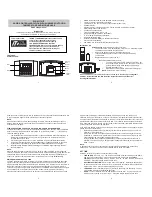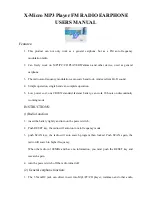
User Manual
RM169-1
Pag. 17
Doc. MI004760-E
Rev. 0
www.seneca.it
ALL RIGHTS RESERVED. NO PART OF THIS PUBLICATION MAY
BE REPRODUCED WITHOUT PRIOR PERMISSION.
Target address:
Contains the value of the destination address and must be equal to the address of the other unit. Example:
Master unit: Its address = 1; Target address = 2. Slave Unit: Its address = 2; Target address = 1.It is evident
that the addresses of the two fields (its own address and the and target address) are reversed between Master
and Slave. In the case of using digipeaters, they must have a different address and the target value is
uninfluenced.
System Code & Digipeater address
(
double click of the mouse on "Target" or [Enter] key
):
When the focus is on the Target field, pressing the "Enter" key on the keyboard or by double clicking the mouse,
a window opens in which you can enter the system code and the addresses of the digipeater path to include in
the radio link.
On the involved units the system code must be the same
.
RF Power:
Allows the choice between three different levels of power: High, Medium, Low. If the RSSI value displayed in
diagnostic parameters of the Slave unit is good (-70 dBm or better), and if the low power of the Master unit is
an important factor, it is advisable to choose a medium or low power level.
Channel sel A LBT:
In this box you choose the radio channel to be used. If you want to use the agility feature (transmission on the
less noisy channel among the active channels), you can select more than one radio channel. The maximum
number of active channels is dependent on the canalization setting.
It is mandatory that in the same network
all the radiomodems use the same radio channels.
In Mirror mode the LBT function cannot be activated.
11.2.
MODBUS LOW ENERGY OPERATING MODE
In this modality the network is composed of one Slave unit and one or more (up to 16) Master unit. The Slave
unit is connected to a PC (or PLC) on which there is a running SCADA software. The slave device is always in
reception, never takes the initiative of the transmission and transmits only in response to a packet received from
a Master unit. The Master units send a packet to the Slave unit using the modbus RTU Protocol. The function
"Write multiple registers (function code 0x10) is used. The transmission of the Master units is triggered by two
events:
1) The expiration of the timer dedicated to the periodical sending;
2) A change of digital inputs on the Master radiomodem.
On each Master device, it is possible to connect, by the RS485 interface, an external Modbus node (Modbus
device that can read digital or analog inputs) in order to extend the number of monitored signals.
Note: You cannot use the digital inputs of an external modbus node to trigger the transmission on the
radiomodem.
In the Master unit, when a transmission is triggered, the value of the digital input is first acquired, the external
node (if present) is read, then the radio modem sends the packet consisting of the collected data.
The slave device receives the packet, controls it, and if there are no errors, it sends the data (payload) to the
SCADA application via the RS485 interface. At this point the SCADA software, connected to the Slave
radiomodem, sends the response packet, which is transmitted back to the Master unit. At the end of the
Communication, the Master unit returns in sleep mode, waiting for a new transmission event.
















































